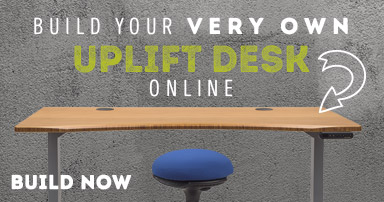Walking (Even While Working) is the Sensible Path to Good Health
Posted by Human Solution on Apr 10th 2013
Some grim statistics: More than one-third of Americans are obese. The rate of Type 2 Diabetes has increased 176% since 1980. Only 3-5% of people meet the minimum recommendations for physical activity (150 minutes of moderate activity per week), and 33% are completely sedentary. Regularly brought on by poor diet, lack of activity, and excess weight, heart disease is the leading cause of mortality in the United States, responsible for 1 in 4 deaths. In fact, obesity and inactivity are responsible for 300,000 premature deaths and over $90 billion in direct health care costs each year. While these statistics should give us pause, what is particularly troubling about them is that they’re primarily the result of diet and lifestyle choices, and are thus largely preventable. In this day and age, though, it can be hard to live the kind of lifestyle that would bring these statistics down.
The very fact of existing in modern society makes it difficult to be healthy. Up until about 150 years ago, 90% of people in the world were agriculturalists1. They spent their days expending calories through constant movement. Today, most of us are sedentary for a good 22 out of every 24 hours. (We have written about the significant dangers of sitting.) The human body has evolved over the course of a million years, but our chair-loving contemporary world has come about only in the last century or so. Of course our bodies are reacting badly; we’re not built to sit all day and feed ourselves refined sugars and processed carbs. We don’t think very often about the implications of our modern lifestyle because it’s all we’ve known. Unless you come from a farming community, you probably don’t know anyone who’s an agriculturist. Half of the modern world now works behind a computer, so sitting seems normal. Everything about contemporary life encourages being sedentary: remote controls, drive-thrus, riding lawnmowers, moving sidewalks, elevators, escalators, the desks most people sit behind for eight hours a day. Add to that the kind of food that's most readily available and economical—over-processed, fast, and full of fattening corn derivatives—and it's no wonder we have such troubling statistics.
Another of our problems, particularly when it comes to losing weight, is that we want immediate results. We want to see that our efforts pay off and pay off quickly. As someone who has long struggled with taking off and keeping off weight, I know it is frustrating to work hard and not see the payoff. So we might consider changing our perspectives and looking long-term instead of always searching for the latest quick fix. It isn’t as immediately satisfying, but it’s more practical and more sustainable. If we're serious about taking personal responsibility for our health and our waistlines, we have to approach the task with common sense and simplicity.
What could be simpler than walking? It's easy, it's accessible, it's sustainable, and it's scientifically proven. In one study, for example, subjects walked at a moderate pace for a total of 30 minutes per day. Moderate means brisk; you shouldn't be huffing and puffing, but you should have slight difficulty holding a conversation. In 12 weeks, the subjects had lost nearly ten pounds each.2 It didn’t matter whether the walking was done in one 30-minute session, two 15-minute sessions, or three 10-minute sessions. Ten pounds in 12 weeks may not sound like much, especially given our tendency to want more and want it faster. But that’s over 40 pounds in a year. You can add to that some simple diet choices as well, such as cutting back on soda or eliminating it entirely, for additional results that will accumulate over time.
There's even more good news. Dr. James Levine is an endocrinologist and professor at the Mayo Clinic, and his specialty is Inactivity Studies, or what’s going on with our bodies when our bodies are doing nothing. (The answer: Sitting Disease.) He has come up with an important distinction between exercise and what he calls NEAT: Non-Exercise Activity Thermogenesis.3 With exercise, we go all-out for an hour or so and burn a lot of calories in one session (that time at the gym is great, but it doesn't offset the health effects of sitting all day). With NEAT, we burn calories through regular, less dramatic movements, such as taking the stairs instead of the elevator, parking far away from the store, getting up from our desks at least once an hour, or walking to a colleague’s cube instead of emailing.
Think of all the small activities you can do each day that will burn calories. A ten-minute walk at lunchtime, a little gardening, some household chores, or being active with your children. Find little ways to move throughout the day, and they'll all add up over time. Slow and steady wins the race. If you're one of the millions who work at a computer all day, one huge way to increase your NEAT is to use a treadmill at a height adjustable desk. Instead of sitting all day, which we know is terribly unhealthy, you can use those work hours to steadily burn calories. Two birds, people!
I’m fortunate to have a treadmill at my desk, which allows me to stroll at around 1.3 miles per hour while working. When I mention my treadmill to friends (which I do all the time because it’s so awesome) they always ask if it’s difficult to work and walk. Honestly, it isn’t. Typing, mousing, talking on the phone, reading: no problem. And I feel more alert, productive, and motivated working this way. I’m also psyched about how much I’m increasing my NEAT, and what that means for my long-term health. Mayo Clinic researchers estimate that replacing your chair with a treadmill desk for part of your workday, walking at one mile per hour, results in a weight loss of up to 66 pounds in one year. Walking is “arguably the most basic of human behaviors for transport and leisure,”4 so why not embrace this simplicity? We’d all be better off if we developed a healthy distrust for the quick fix and a respect for common-sense methods of living well.
We spend the majority of our days at our workplaces, so it makes sense to focus on increasing NEAT at work. We already know we have to get out of our chairs or deal with the frightening consequences. Dr. Levine believes that in the next 10 to 20 years, active offices will be the norm. I'm lucky to be at a workplace that already recognizes the benefits of providing a healthy environment for employees. We hope you will join us in the active office revolution, walking your way to health and wellness.
1. Levine, James, M.D., Ph.D. "Chair Today, Gone Tomorrow." Nutrition Action Health Letter, April 2008.
2. Simon, Harvey B. "Big Benefits from Small Changes." Newsweek, January 16, 2006.
3. Levine, James, M.D., Ph.D. "Non-Exercise Activity Thermogenesis (NEAT)." Nutrition Reviews, July 2004.
4. Norman, Gregory J., and Paul J. Mills. "Keeping it Simple: Encouraging Walking as a Means to Active Living." Annals of Behavioral Medicine, 2004.
To learn more about what makes for a healthy office, visit TheHumanSolution.com.




